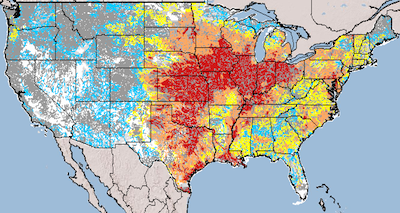Submitted by Rebekah Wilce on
Atrazine is an herbicide primarily manufactured by the multinational conglomerate Syngenta and commonly used on commodity crops, forests, and golf courses. Its potential harmful effects on human health have been documented since the 1990s.
As a consequence, atrazine has been "unauthorized" in the European Union since 2004 (and in some European countries since 1991). However, it is one of the most heavily used herbicides in the United States. Syngenta, atrazine’s primary manufacturer, has spent hundreds of millions combined on marketing, public relations (PR) campaigns, and lobbying to maintain its market and fight calls to phase the product out of use in the U.S.
 Atrazine is big business for the Switzerland-based holding company and its American arm, Syngenta Crop Protection, Inc. (Syngenta CP). The company does not disclose its profits from selling atrazine, but its overall revenue in 2010 was $11 billion, with over $5 billion in profits. Its income is on track to be over $13 billion for 2011, with millions in compensation to its executives, including $5 million a year in compensation to its CEO, Michael Mack. Mack is chairman and president of the Board of the Swiss-American Chamber of Commerce, an affiliate of the controversial U.S. Chamber of Commerce that has attacked EPA regulations of chemicals like atrazine.
Atrazine is big business for the Switzerland-based holding company and its American arm, Syngenta Crop Protection, Inc. (Syngenta CP). The company does not disclose its profits from selling atrazine, but its overall revenue in 2010 was $11 billion, with over $5 billion in profits. Its income is on track to be over $13 billion for 2011, with millions in compensation to its executives, including $5 million a year in compensation to its CEO, Michael Mack. Mack is chairman and president of the Board of the Swiss-American Chamber of Commerce, an affiliate of the controversial U.S. Chamber of Commerce that has attacked EPA regulations of chemicals like atrazine.
As part of its analysis of Syngenta’s recently-revealed PR operations, the Center for Media and Democracy (CMD) has surveyed some of the scientific reports raising concerns about the health effects of atrazine, how humans are exposed to the chemical, and why regulation has not sufficiently protected Americans’ drinking water from continued exposure to atrazine.
Atrazine’s Potentially Harmful Effects on Humans
Dr. Warren Porter, a renowned toxicologist at the University of Wisconsin - Madison (UW-Madison) who studies pesticide exposure in vertebrates, explained to CMD, "Atrazine is a molecular bull in a china shop, and the china shop is you."
Dr. Porter summarized atrazine’s effects this way: "Atrazine alters sexual hormone levels, and the effects of that, especially at the embryonic stage, can be life-threatening or have life-long impacts. If it affects the immune system, and it can, then it can be life-threatening, or cause long-term chronic inflammation and all kinds of long-term chronic disease. The nervous, endocrine and immune systems are all interconnected, and if you get hit on any of them, you're likely to get hit on them all."
Here is a snapshot of the health concerns raised in scientific literature over the past several years:
Menstrual Cycle Irregularity: A January 2011 study by Dr. Lori Cragin of Colorado State University and others found "preliminary evidence that atrazine exposure, at levels below the US EPA MCL [ U.S. Environmental Protection Agency maximum contaminant levels], is associated with increased menstrual cycle irregularity, longer follicular phases, and decreased levels of menstrual cycle endocrine biomarkers of infertile ovulatory cycles."
Hormonal Disruption and Potential Gender Changes: A March 2011 study by Dr. Tyrone Hayes of the University of California – Berkeley and 21 other scientists from around the world found that "atrazine demasculinizes male gonads producing testicular lesions associated with reduced germ cell numbers in teleost fish, amphibians, reptiles, and mammals, and induces partial and/or complete feminization in fish, amphibians, and reptiles. These effects are strong (statistically significant), consistent across vertebrate classes, and specific. Reductions in androgen levels and the induction of estrogen synthesis – demonstrated in fish, amphibians, reptiles, and mammals – represent plausible and coherent mechanisms that explain these effects."
Small Birth Size: A July 2011 study from the University of Rennes, France, found that "presence versus absence of quantifiable levels of atrazine or a specific atrazine metabolite [atrazine mercapturate] was associated with fetal growth restriction (OR=1.5; 95% CI: 1.0-2.2) and small head circumference for sex and gestational age (OR=1.7; 95% CI: 1.0-2.7)." A 1997 study from the University of Iowa preliminarily found that "communities in southern Iowa with drinking water supplies contaminated with ... elevated levels of triazine herbicides" (the class of herbicide that includes atrazine) "have elevated rates of IUGR [intrauterine growth restriction] compared to neighboring communities with different water supplies. ... The association with IUGR was strongest with atrazine..."
Birth Defects: A 2008 study from the Indiana University School of Medicine concluded that "total birth defects, and eleven of 22 birth defect subcategories, were more likely to occur in live births with LMPs [last menstrual periods] between April and July. A significant association was found between the season of elevated agrichemicals [nitrates, atrazine and other pesticides] and birth defects." A 2004 study from the Marshfield Clinic Research Foundation tested atrazine along with other herbicides and pesticides in "residential use" and concluded that "pesticide-induced injury can occur very early in development, with a variety of agents, and at concentrations assumed to be without adverse health consequences for humans."
Compromised Endocrine, Immune and Nervous System: A 1999 study (PDF) by Dr. Porter of UW-Madison and others found that "mixtures of aldicarb, atrazine, and nitrate" at concentrations of "the same order of magnitude as current maximum contaminant levels (MCLs) for all three compounds" caused "endocrine, immune, and behavior changes ... due to doses of mixtures." For example, it found alterations in "aggressive behavior, thyroxine hormone levels, and ability to make antibodies against a foreign protein."
These last two studies tested the effects of chemicals in combination, as opposed to atrazine alone. Scientists CMD spoke with explained that it is important to study the effects of atrazine in combination with other chemicals because humans tend to be exposed to more than one chemical at the same time.
Means of Exposure: Still Poisoning the Well
The EPA regulates atrazine usage on "broadleaf and some grassy weeds for a variety of major and minor crops and nonagricultural uses," but critics contend the EPA limits and measurements are too low and that the product should be subject to stricter controls and phased out. In the United States, when a company applies to have a chemical approved -- or "registered"-- for certain uses, the EPA is supposed to evaluate the chemical "to ensure that it will not have unreasonable adverse effects on humans, the environment and non-target species."
Atrazine was last reviewed in 2006 as part of its re-registration (PDF) during the Bush Administration. Atrazine is currently undergoing reevaluation by the EPA based on growing evidence and concerns about its potential to disrupt the human endocrine system.
How are Children and Adults Exposed to Atrazine?
 Atrazine is in widespread use on farms in part because of Syngenta’s claims that using the herbicide significantly boosts yields of crops like corn. Syngenta claims, through a researcher on "Syngenta’s Benefits Panel," agriculture and applied economics professor Dr. Paul D. Mitchell at UW-Madison, that "based on yield loss (PDF) and herbicide cost changes estimated using models, the economic value of the yield losses prevented by the triazine herbicides [including atrazine] are estimated to range between $3.0 and $3.3 billion per year for U.S. corn, sorghum, sweet corn, and sugarcane farmers." Syngenta has funded other academics who echo this theme.
Atrazine is in widespread use on farms in part because of Syngenta’s claims that using the herbicide significantly boosts yields of crops like corn. Syngenta claims, through a researcher on "Syngenta’s Benefits Panel," agriculture and applied economics professor Dr. Paul D. Mitchell at UW-Madison, that "based on yield loss (PDF) and herbicide cost changes estimated using models, the economic value of the yield losses prevented by the triazine herbicides [including atrazine] are estimated to range between $3.0 and $3.3 billion per year for U.S. corn, sorghum, sweet corn, and sugarcane farmers." Syngenta has funded other academics who echo this theme.
However, a 22-year farming trial reviewed in 2005 by Cornell University professor of ecology and agriculture Dr. David Pimentel found that "organic farming produces the same yields of corn and soybeans as does conventional farming, but uses 30 percent less energy, less water and no pesticides."
And Dr. Frank Ackerman, an economist at the Global Development and Environment Institute at Tufts University, published a review of studies on atrazine (PDF) in 2007, including studies by the USDA, EPA and two by scientists paid by Syngenta. In an article Ackerman wrote for the Omaha World-Herald, he explained: "My research on the economics of atrazine shows that its benefits are greatly exaggerated. Corn yields and farm incomes would barely be affected by switching from atrazine to the next-best alternatives."
Ackerman added, "Two corn-growing countries, Germany and Italy, both banned atrazine in 1991. I compared the trends in corn yields per acre, and in corn acreage, in the United States, Germany, and Italy for 1981-2001. Both Germany and Italy did as well or better in corn production after banning atrazine as they did in the 10 years before the ban. And both countries did as well or better than the United States after banning atrazine."
However, many conventional farmers continue to believe that atrazine use is vital to the monoculture farming that has emerged to fuel ethanol and other markets.
The result is that tens of millions of pounds of atrazine are applied to fields in the U.S. each year, and some of makes its way into drinking water systems, where it is considered a "persistent" contaminant (PDF, p. 53). This means that it does not break down chemically, or that it breaks down very slowly, and therefore remains in the environment after a growing season. Almost 94 percent of U.S. drinking water contains some degree of atrazine, according to the Pesticide Action Network.
 The National Resources Defense Council (NRDC) published a report (PDF) on atrazine in 2009, in which it analyzed data compiled by the EPA’s Ecological Watershed Monitoring Program and Atrazine Monitoring Program from 2003 through 2006. It found that 40 out of 40 watersheds in the Midwestern and Southern United States contained atrazine, with nine of those watersheds intermittently peaking above 50 parts per billion (ppb) (with spikes in some cases above 200 ppb). It also found that more than 90 percent of drinking water samples from 139 public water systems contained atrazine, with 54 of those systems peaking at more than 3 ppb atrazine in their treated tap water.
The National Resources Defense Council (NRDC) published a report (PDF) on atrazine in 2009, in which it analyzed data compiled by the EPA’s Ecological Watershed Monitoring Program and Atrazine Monitoring Program from 2003 through 2006. It found that 40 out of 40 watersheds in the Midwestern and Southern United States contained atrazine, with nine of those watersheds intermittently peaking above 50 parts per billion (ppb) (with spikes in some cases above 200 ppb). It also found that more than 90 percent of drinking water samples from 139 public water systems contained atrazine, with 54 of those systems peaking at more than 3 ppb atrazine in their treated tap water.
3 ppb of atrazine in drinking water is what the EPA determined in 1992 would be likely to cause no adverse health effects. However, research by Dr. Tyrone Hayes shows "effects of atrazine on sexual development in African clawed frogs" at exposure levels of 0.1 to 1 ppb.
The NRDC's findings, combined with the number of new scientific studies of atrazine’s effects published between its re-registration in 2006 and the NRDC report’s publication in 2009, helped spur the EPA to begin a re-evaluation of atrazine’s human health effects, a process which is still ongoing.
NRDC issued an updated report (PDF) in 2010. That report found that 20 out of 20 watersheds in the Midwestern United States contained atrazine, with 18 of them severely contaminated at times (with spikes in some cases above 100 ppb). It also found that 80 percent of drinking water samples from 153 public water systems across the United States contained atrazine, with 100 of those systems peaking at more than 3 ppb atrazine in their untreated water and two-thirds of those 100 systems peaking at more than 3 ppb even in their treated water.
Some farmers think Atrazine is not worth the risk. John Kinsman, longtime Wisconsin organic dairy farmer and president of Family Farm Defenders, told CMD, "Shortly after atrazine was first made available to farmers, I heard salesmen say it was so safe you could drink it. Some of them even did. When legislation was introduced in Wisconsin in the 1990s to increase the allowable limits for atrazine in drinking water, I was the only farmer to testify in opposition, along with Dr. Warren Porter, a toxicologist at UW-Madison. Of course, our warnings back then have now been proven true -- that atrazine poses a grave threat to human health, especially in combination with other chemicals, since the danger is multiplied many times."
Kinsman also shared his opinion that "this is a deadly chemical that never goes away and that should be banned for good."
Atrazine Sprayed by Helicopter on Forests
Lisa Arkin, executive director of the Oregon-based environmental group Beyond Toxics, told CMD that atrazine is also used extensively in forestry. Timber companies clear-cut a forest, and then plant new trees to "harvest" again when grown. To help them get established, the companies apply herbicides to discourage competition from other plants. Arkin explains:

Atrazine is being sprayed by helicopter all over forest lands throughout the nation, but particularly in the northwest. The difference is, if you were to imagine a cornfield, you have miles of flat earth... Now picture craggy, forested mountains, with high and low elevations and fluctuating wind currents and different weather patterns, and imagine a helicopter with blades whirring and the stuff pouring out of the booms."
"Here in the forest of Oregon you have little tiny streams, called ephemeral streams or first-order streams, that are not necessarily mapped, so the helicopter pilots don't know to avoid them. Plus they're spraying transversely across the mountain slope, whereas streams go up and down. If a stream is classified as an N stream, meaning they haven't seen fish in it, then they don't require a buffer zone. But that N stream might join a fish stream a quarter mile away. This paints the picture for you of what's going on with the use of atrazine in forestry."
High Levels of Atrazine Found in Urine Samples in the Northwest
Arkin's organization leads the "Oregon Pesticide Action Workgroup," a grassroots network of Americans who believe their health and livelihood have been adversely affected by what Arkin describes as "involuntary exposure to pesticides that drift over their private property and impact them, their family, their livestock, and the wildlife on their property," or get into their water systems. In Arkin’s view, "This pesticide drift is not acknowledged by industry or the Department of Forestry, which claims that all herbicide applicators are doing things perfectly."
 In the spring of 2011, the Emory University School of Public Health tested the urine of people aged between seven and seventy living in the west coast range of Oregon. The test was done twice, once before and once after aerial spraying. These tests found that most of the sample population had metabolites of atrazine in their urine at levels much higher than average, even before the spraying. Residents CMD spoke with believe that the continual rounds of aerial and ground spraying in western Oregon have affected both people and the environment. (Additionally, urine in almost 100 percent of the sample was found to have 2,4-Dichlorophenoxyacetic acid (2,4-D), another broadleaf herbicide that was a major component of Agent Orange and is more commonly used in non-agricultural settings such as along roadsides.)
In the spring of 2011, the Emory University School of Public Health tested the urine of people aged between seven and seventy living in the west coast range of Oregon. The test was done twice, once before and once after aerial spraying. These tests found that most of the sample population had metabolites of atrazine in their urine at levels much higher than average, even before the spraying. Residents CMD spoke with believe that the continual rounds of aerial and ground spraying in western Oregon have affected both people and the environment. (Additionally, urine in almost 100 percent of the sample was found to have 2,4-Dichlorophenoxyacetic acid (2,4-D), another broadleaf herbicide that was a major component of Agent Orange and is more commonly used in non-agricultural settings such as along roadsides.)
Based on these results, the CDC, the Oregon Health Authority, and the Oregon Departments of Agriculture and Forestry have announced a formal investigation into the spraying of herbicides on timberland in rural Oregon. The state has not yet released its summary report. When the CDC and the Oregon Health Authority requested that the Oregon Department of Forestry turn over spray records for the period of time when Barr's study was done, Arkin says, they refused, saying it would be an "unfair burden to the timber companies." The request was made on October 13, 2011, and they still don't have the records.
EPA Failing to Take Action on Atrazine
As noted above, the EPA is currently re-evaluating atrazine’s human health effects based on its prevalence in drinking water. In addition to NRDC’s 2009 report and the publication of several new scientific studies about atrazine’s effects, a petition organized by Save the Frogs helped induce the EPA to open a period of public commentary that concluded on November 14, 2011. All this activity has led to a renewed focus on Syngenta’s lobbying and PR efforts in support of this dangerous chemical.
EPA’s Regulatory System Flawed
Scientists CMD spoke to believe that the U.S. EPA’s 35-year old system for evaluating chemicals is severely flawed. In contrast, Europe applies the precautionary principle -- a "first do not harm" approach -- towards chemical regulation in an effort to prevent irreversible damage to human health and the environment. Atrazine has been "unauthorized" in the 26 EU member states since 2004.
Kathryn Gilje, co-director of the Pesticide Action Network of North America (PANNA), told CMD that in the U.S., "our national pesticide policy is really broken, and it leaves chemicals that cause human and environmental harm on the market long past when the scientific evidence is in. It assumes chemicals are innocent until proven guilty. The process of proving a chemical guilty is onerous," she says, so a chemical will stay on the market until the evidence is so compelling that national regulators and policymakers can no longer ignore it. "In the meantime," she says, "Syngenta backs certain studies and intimidates scientists that speak up on the harm they're finding with atrazine, which stymies the debate. And atrazine stays on the market until action is taken."
In addition, scientists like Dr. Porter, the UW-Madison toxicologist, argue that the EPA has flawed scientific assumptions in its chemical review and regulation process. EPA sets standards for chemicals in drinking water -- such as the 3 ppb standard for atrazine -- even though, according to Dr. Porter, much smaller doses can have harmful effects.
Dr. Porter explained to CMD that, especially with hormone chemicals, different concentrations can have very different effects, often in ways that are counter-intuitive. This is contrary to Paracelsus' 16th century theory, which Dr. Porter believes the EPA still uses and which is often cited by Syngenta, that "the dose makes the poison." That 500-year old analysis is too simplistic and does not hold up to tests like those Dr. Porter and others have done, which are made possible by the more sensitive equipment available to modern science. For example, he said, aldicarb, a chemical that used to be commonly used on potato crops, has either no effect or a stimulant effect on the immune system at higher concentrations, but at concentrations as low as 1 ppb, it is a severe immune suppressant.
The chemical atrazine, he explained, affects the enzyme aromatase, which converts testosterone to estrogen. So for females, who go through estrogen cycles -- low estrogen levels suppressing ovulation and higher levels stimulating it -- they get two very different effects from the same chemical, depending on the level. These levels range from about 40 to 400 parts per trillion (ppt), he said.
For male vertebrates, the conversion of testosterone to estrogen effeminates organisms. So, especially when exposed during development, and even at low levels of atrazine such as are found in groundwater, these estrogenic molecules can cause physical changes that basically change the sex of the organism.
Dr. Porter also believes that the EPA registration process is flawed because the EPA tests and registers the active ingredient rather than the chemical cocktail that is sold. He explained that the products sold to pesticide applicators and consumers consist of the active ingredient -- in this case atrazine -- combined with "solvents and surfactants that promote rapid penetration of the skin and the respiratory surfaces." This potentially exacerbates the impact of the active ingredient. "Once inside an organism," Porter says, what chemical product labels refer to as "inert" ingredients "promote rapid entry across all cell membranes, and access to every cell in the body, from gonads to brain and sex activity centers."
Miscarriages, Too?
Jan Wroncy and Gary Hale are organic farmers in Blachly, Oregon. They've lived and farmed there since moving to rural Oregon in 1979. Jan gave birth to their son in 1980. Since then, Jan and Gary have tried to have more children, but by their estimate, Jan has had 15 or 20 miscarriages. They believe this was due in part to exposure to atrazine and other herbicide and pesticide sprays over the years.
The Hales were part of the Emory University testing last spring. The sample population in their area tested positive for atrazine and the herbicide 2,4-D at levels of 60 to 100 times that of the average United States population (an average calculated by the U.S. Centers for Disease Control (CDC)).
In their opinion, the atrazine and other chemicals in the drinking supply constitute an unacceptable risk. Jan, who recently had a stroke, said quietly but with emphasis, "It is in the air, in the water, it is everywhere." Her husband Gary elaborated on their views: "Corporations have taken all our wealth, now they want all our health. They will poison us as long as we allow them to do it. We must adopt a precautionary principle when regulating chemicals and genetic manipulation."
About the Author: Rebekah Wilce has a degree in writing from the University of Arizona. She is the lead writer for CMD's Food Rights Network, with expertise in food and agriculture issues.
About this Project: Documents obtained by CMD, recently unsealed as part of a major lawsuit against Syngenta, reveal how the global chemical company's PR team investigated the press and spent millions to spin news coverage and public perceptions in the face of growing concerns about potential health risks from the widely used weed-killer atrazine. This story is part three of a series about Syngenta's PR campaign to influence the media, potential jurors, potential plaintiffs, farmers, politicians, scientists, and the EPA in the midst of reviews of the weed-killer's potential to act as an endocrine disruptor and concerns about the persistence of the chemical and its metabolytes in drinking water.
For More Information: The U.S. Geological Survey is one resource for citizens to look at the levels of atrazine in water. Click here for an interactive map. To see a list of products containing atrazine, click here. To see the documents released as part of this investigative series, click here.
